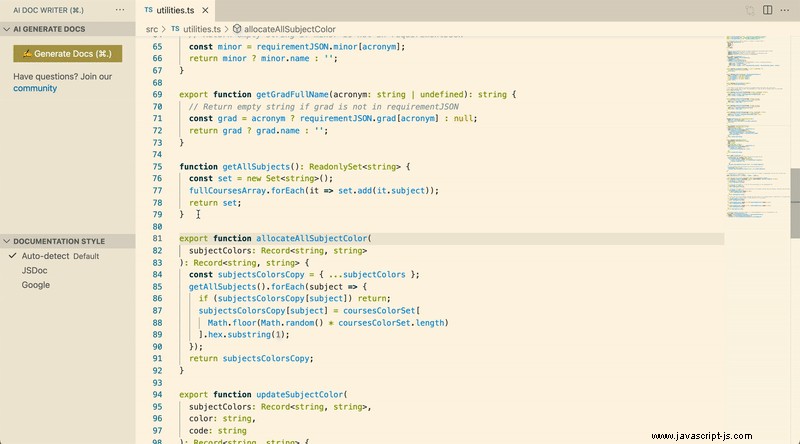Es gibt diese ziemlich neue Erweiterung auf dem VS Code-Marktplatz namens AI Doc Writer für JavaScript, TypeScript und Python. Hier ist, was die README sagt:
Schritt 1 Code markieren
Schritt 2 Klicken Sie auf die Schaltfläche Dokumente schreiben (oder drücken Sie ⌘ + .)
Also habe ich es getestet, um zu sehen, wie gut es wirklich ist.
So lief es bei einem JS-Code:

/**
* return a set of all the subjects in the fullCoursesArray.
* @returns A set of all the subjects.
*/
function getAllSubjects(): ReadonlySet<string> {
const set = new Set<string>();
fullCoursesArray.forEach(it => set.add(it.subject));
return set;
}
/**
* For each subject, if it has a color, do nothing. Otherwise, give it a random color from the color
set.
* @param subjectColors - The subject colors that are currently in use.
* @returns A new object with the same keys as the original object, but with new values.
*/
export function allocateAllSubjectColor(
subjectColors: Record<string, string>
): Record<string, string> {
const subjectsColorsCopy = { ...subjectColors };
getAllSubjects().forEach(subject => {
if (subjectsColorsCopy[subject]) return;
subjectsColorsCopy[subject] = coursesColorSet[
Math.floor(Math.random() * coursesColorSet.length)
].hex.substring(1);
});
return subjectsColorsCopy;
}
/**
* Update the subjectColors object with the new color for the given subject.
* @param subjectColors - The current subject colors.
* @param {string} color - The color to be applied to the subject.
* @param {string} code - The subject code of the subject to update.
* @returns A new object with the updated color.
*/
export function updateSubjectColor(
subjectColors: Record<string, string>,
color: string,
code: string
): Record<string, string> {
const subjectsColorsCopy = { ...subjectColors };
getAllSubjects().forEach(subject => {
if (subject === code) {
subjectsColorsCopy[subject] = color;
}
});
return subjectsColorsCopy;
}
/**
* When the user clicks outside of the element, the `clickOutside` event handler is called.
*/
export const clickOutside = {
// eslint-disable-next-line @typescript-eslint/no-explicit-any
beforeMount(el: any, binding: any): void {
el.clickOutsideEvent = (event: Event) => {
if (!(el === event.target || el.contains(event.target))) {
binding.value(event, el);
}
};
document.body.addEventListener('click', el.clickOutsideEvent);
},
// eslint-disable-next-line @typescript-eslint/no-explicit-any
unmounted(el: any): void {
document.body.removeEventListener('click', el.clickOutsideEvent);
},
};
Ich habe es auch mit Python-Code versucht:
def collect_dataset():
'''
The function is used to collect the data from the github repository.
:return: A matrix of the dataset.
'''
response = requests.get(
"https://raw.githubusercontent.com/yashLadha/"
+ "The_Math_of_Intelligence/master/Week1/ADRvs"
+ "Rating.csv"
)
lines = response.text.splitlines()
data = []
for item in lines:
item = item.split(",")
data.append(item)
data.pop(0) # This is for removing the labels from the list
dataset = np.matrix(data)
return dataset
def run_steep_gradient_descent(data_x, data_y, len_data, alpha, theta):
'''
This function runs the gradient descent algorithm.
:param data_x: the data matrix
:param data_y: the actual y values
:param len_data: the number of data points
:param alpha: learning rate
:param theta: The initial value of theta
:return: Theta
'''
n = len_data
prod = np.dot(theta, data_x.transpose())
prod -= data_y.transpose()
sum_grad = np.dot(prod, data_x)
theta = theta - (alpha / n) * sum_grad
return theta
def sum_of_square_error(data_x, data_y, len_data, theta):
'''
It calculates the sum of squared error for the given data and the given theta.
:param data_x: the data matrix
:param data_y: the y values of the data
:param len_data: the number of data points
:param theta: theta vector
:return: The sum of the squares of the errors.
'''
prod = np.dot(theta, data_x.transpose())
prod -= data_y.transpose()
sum_elem = np.sum(np.square(prod))
error = sum_elem / (2 * len_data)
return error
def run_linear_regression(data_x, data_y):
'''
Runs gradient descent on the data and returns the final theta vector.
:param data_x: The training data
:param data_y: The dependent variable
:return: Theta
'''
iterations = 100000
alpha = 0.0001550
no_features = data_x.shape[1]
len_data = data_x.shape[0] - 1
theta = np.zeros((1, no_features))
for i in range(0, iterations):
theta = run_steep_gradient_descent(
data_x, data_y, len_data, alpha, theta)
error = sum_of_square_error(data_x, data_y, len_data, theta)
print("At Iteration %d - Error is %.5f " % (i + 1, error))
return theta
Was denkt ihr?
